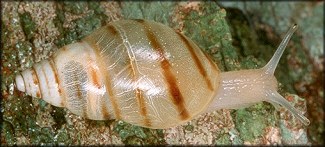| Mollusks And The Media | |
| By Harry G. Lee | |
| It's not very
often that we notice snails making news, but two interesting
journalistic pieces attracted my attention lately. Though both
deal with Florida mollusks, there is a hiatus of 80 years in
their publication and a considerable contrast in veracity between
the two.
The Jacksonville Citizen had a brief existence in the mid-eighteen-nineties as a daily newspaper.(1) At one point the following item (presumably as a 'filler') appeared: "One of the most beautiful shells found along our coast is that of a large snail which climbs certain trees and grows delicately fat on young birds. The shell is as thin as tissue paper, oddly curved and almost as transparent as the finest glass … It is most abundant about New River Inlet,(2) where the slight shake of a tree about sunset will bring a shower them to the ground."(3) |
|
|
|
|
|
Drymaeus dominicus - On hardwoods, The Barnacle, Coconut Grove, Miami, Miami-Dade Co., Florida (20 mm.) | |
|
Pomacea paludosa (Say, 1829) - Lake Eloise, Cypress Gardens, Florida (37-45 mm.) | |
| Almost certainly
the snail in question is Drymaeus dominicus
(Reeve, 1850). The descriptions of its
habitat and its shell are excellent, but that of its feeding
habits fantastically inaccurate ---approaching Clyde Hebert's
barnacles which metamorphose into geese.(4) Nowadays we know this
tree snail, like its cousin Liguus, is an
herbivore with an unusual preference for arboreal molds.(5)
Fortunately, the Citizen's readers didn't
declare all-out war on the innocent Drymaeus,
and these creatures are still carrying on their salutary services
in large areas of peninsular Florida.
Last month, the Florida Time-Union,(6) 80 years after it had absorbed the hapless Citizen, carried an interesting Associated Press release detailing plans for an extensive dike system to create snail-breeding impoundments in Loxahatchee Wildlife Refuge (which is located a mere 20 miles N. W. of New River Inlet). Beginning in 1981 apple snails would be raised to feed the endangered Everglades Kite, which species has been reduced to only 150 individuals. As pointed out by John Lott,(7) the Apple Snail, Pomacea paludosa (Say, 1829) is the only food of this stately predator, whose hooked beak is specialized to pry open the snail's operculum. According to B. H. Powell, assistant refuge manager, "We think (the snail pond) is the best, if not the only, chance to save the Kite during years of drought." Of course it is impossible to draw far-reaching conclusions from these two isolated journalistic accounts, but from the limited perspective of an amateur malacologist, I am impelled to speculate that:
| |
| Footnotes: | |
| (1) Davis, T. F. (1925) History of Jacksonville, Florida & Vicinity 1513 to 1934 Florida Historical Society, St. Augustine | |
| (2) Near Ft. Lauderdale, Broward Co., FL | |
| (3) Abbott, R. T. (1976) (editor) The Best of the Nautilus, American Malacologists, Greenville, DE | |
| (4) Shell-O-Gram 8/77 | |
| (5) Ibid, 11/77; see also 5/76 & 7/77 issues | |
| (6) Anon., Rare Bird May Cost Taxpayers Millions to Feed, Florida Times-Union Dec. 16, 1977 | |
| (7) Shell-of-the-Month presentation 3/76; Shell-O-Gram 4/77 | |

